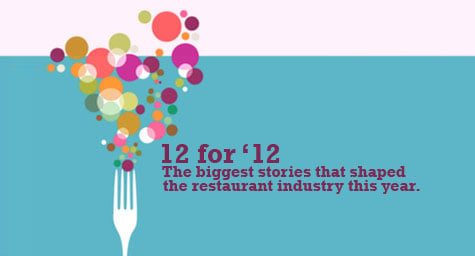The 12 Biggest Stories That Shaped the Restaurant Industry in 2012


2012 brought major changes for the restaurant industry, both from external forces and internal factors. For a look back at the trends, triumphs, and trials that defined the past year in dining, QSRMagazine.com compiled the 12 most significant events and evolutions.
1. Erratic Economy – While the economy had been looking better for most of 2012, it has recently showed signs of weakening. This has made restaurant operators wary of what to expect in 2013 given the recent volatility.
2. Healthcare Hassles – Issues related to healthcare continue to plague the restaurant industry as everyone struggles with Obamacare, which is formally known as the Patient Protection and Affordable Care Act (PPACA.) This controversial healthcare act will cause many restaurants to undergo major cost analyses and operational changes in preparation for the onslaught of regulations that are scheduled to start in 2014. One particular regulation regards the listing of calories by chains with more than 20 locations, which has already inspired some restaurants to add more healthful choices to their menus to prepare for this major change.
3. City Soda Ban – With New York City’s imminent ban on serving large sodas beginning in March 2013, the restaurant industry is watching and waiting to see whether the move is overturned or makes its way across the country.
4. Climbing Commodity Costs – The country’s worst drought in 25 years had a huge effect on agriculture and food prices nationwide, which already has resulted in much higher food costs and devastation to our fields. In 2013, it’s expected to result in higher prices for beef, poultry, and pork, as well.
5. Create-Your-Own Copycats – The consumer’s growing desires to both customize their meals and know exactly what’s in their food has led to the popularity of the interactive dining experience popularized by Chipotle and Subway. Consumers love being able to choose the ingredients in their meals, so this concept continues to sweep the industry and appear in chains of all kinds. “Customers want to be part of the process, and the visual impact is important,” says Darren Tristano, executive vice president of Technomic Inc., a Chicago consulting and market research firm. “Interactivity engages the customer. This is an emotional connection that makes loyal fans of these restaurants.”
6. Casual as King – While a majority of the restaurant industry struggled during the recession, fast-casual establishments performed extremely well last year as diners traded regular lavish meals for more-frequent casual dining with high quality and good value. As a result, a number of traditional restaurants opened casual offshoots with lower prices to attract this growing segment of diners.
7. Ethnic Exploration – In 2012, Americans expanded their tastes beyond the usual Chinese and Italian favorites in favor of new cuisines from around the world. Asian, Middle Eastern, and Indian specialties tempted consumers with exciting flavors that got consumers hooked on expanding their dining horizons.
8. Food Truck to Storefront – In a surprising reverse move, many successful food trucks have started opening their own storefront locations. The recession had originally attracted many people to the lower costs and freedom of the food truck business, yet many have become successful enough to expand their brands into more stable brick-and-mortar sites.
9. Pinterest Popularity – After establishing themselves on social media networks like Facebook and Twitter, restaurants are now discovering newer channels like the hugely popular Pinterest. The photo-sharing nature of Pinterest helps restaurants draw consumers into their communities and share in the dining experience.
10. Boomers as Buyers – Millennials became a hot target market for restaurants in 2012, but they now realize that the Baby Boomers are the market with the greatest purchasing power. “Boomers are increasing their visits to all restaurant types, but particularly quick service … and fast casual,” said Bonnie Riggs, restaurant analyst with NPD Group market research company. “It’s really the Boomers and those over 65 that are keeping the industry from experiencing a decline.”
11. An Eye on IPOs – Restaurant stock deals commanded headlines in 2012 as some many major chains embarked on plans to go public. Some succeeded while others failed, but their efforts sparked a new focus on IPOs in the restaurant industry.
12. Brand Evolution Revolution – A number of notable chains experienced significant menu makeovers last year as these brands strived to meet the rapidly changing needs of consumers. From offering higher-quality ingredients to exploring new mealtime segments, restaurant brands showed a strong willingness to evolve to the trends and tastes of the times.
To discover how creative restaurant marketing can capture your audience’s attention, contact MDG.
MDG is a full-service advertising agency and one of the top Florida marketing companies, with offices in Boca Raton and New York, NY. MDG’s 360° integrated marketing strategy uses just the right mix of traditional and digital to reach your goals. While some industries may fare better in print and others online, we strive to create a balanced approach where traditional and digital marketing efforts support each other and your marketing message is tailored to the medium. To stay on top of the latest market trends for restaurants, contact MDG to view some of our creative restaurant marketing work.
Read more at QSR.
